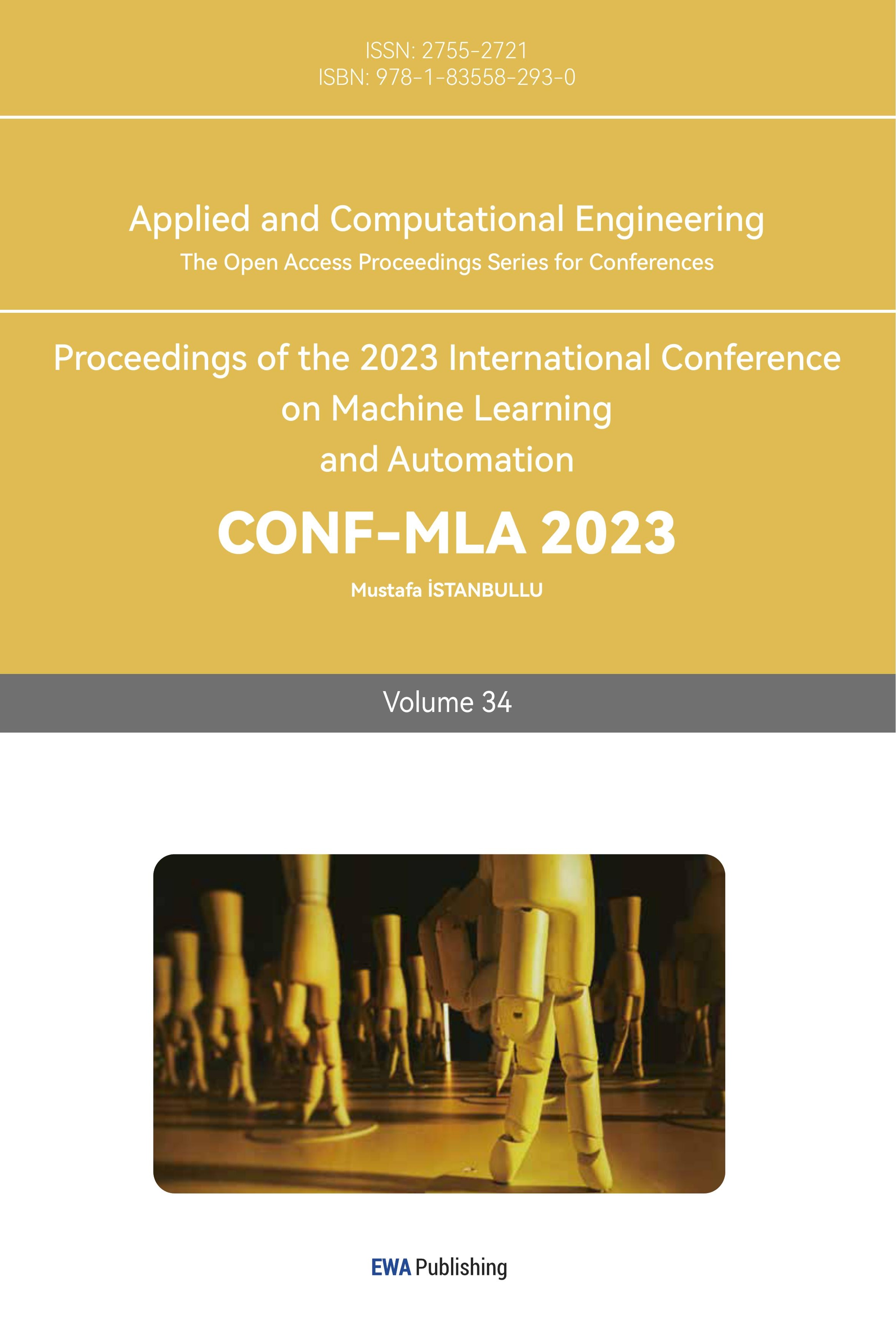References
[1]. Liu, X., Sang, C., Li, Y., You, B., & Liu, C. Patrol UAV based on PID algorithm. In Southeast University Chengxian College, Nanjing, Jiangsu, China.
[2]. Shao, L., Liao, F., Ding, L., Shu, W., & He, Z. PID simulation design of quadcopter drone flight control based on MATLAB. In School of Electrical and Information Engineering, Huaihua University, Huaihua, Hunan, China.
[3]. Cen, Z., Yue, X., Wang, L., Ling, K., Cheng, Z., & Lu, Y. Design and experimentation of UAV adaptive variable spraying system based on neural network PID. In College of Electronic Engineering, South China Agricultural University, Guangzhou, Guangdong, China.
[4]. Zhang, X., Yu, F., & Liu, C. Design of quadcopter drone based on fuzzy PID control. In (1. School of Information Business, Zhongyuan Institute of Technology, Zhengzhou 451191, China; 2. School of Information Science and Engineering, Wuhan University of Science and Technology, Wuhan 430081, China).
[5]. Wang Hongfei, Shi Yongkang. “ROI-Accelerated Autonomous and Precise Landing System for Unmanned Aerial Vehicles.” Modern Electronics Technique, 2023, 46(6): 85-90. DOI:10.16652/j.issn.1004-373x.2023.06.016.
[6]. Zhao Qi, Zhen Ziyang, Gong Huajun, et al. “Unmanned Aerial Vehicle Formation Control Based on Deep Reinforcement Learning.” Electron, Optoelectronics and Control, 2022, 29(10): 29-33, 63. DOI:10.3969/j.issn.1671-637X.2022.10.006.
[7]. Chen, Jundong. “Tuning PID Control Parameters for Quadrotor UAV Based on Improved Genetic Algorithm.” Modern Information Technology, 2023, 7(11), 175-178. DOI: 10.19850/j.cnki.2096-4706.2023.11.040.
[8]. Zhang, Yibo; Wu, Huanyu; Qi, Haoyu. “Optimal Positioning Model for UAV based on Simulated Annealing Algorithm.” China High-Tech Zone, 2019, (4), 50. DOI: 10.3969/j.issn.1671-4113.2019.04.040.
[9]. Li, Yan; Wu, Zhiming. “Grouping Method of Manufacturing Units Based on GA and SA.” Control and Decision, 2000, 15(6), 654-657. DOI: 10.3321/j.issn:1001-0920.2000.06.004.
[10]. Liu, Xinyu; Sang, Chen; Li, Yuanyuan, et al. “Patrolling UAV based on PID Algorithm.” Modern Information Technology, 2022, (20), 141-145, 151. DOI: 10.19850/j.cnki.2096-4706.2022.20.033.
Cite this article
Yuan,X. (2024). Achieving stable trajectory tracking in complex environments using an adaptive PID control strategy-based quadcopter drone. Applied and Computational Engineering,34,212-225.
Data availability
The datasets used and/or analyzed during the current study will be available from the authors upon reasonable request.
Disclaimer/Publisher's Note
The statements, opinions and data contained in all publications are solely those of the individual author(s) and contributor(s) and not of EWA Publishing and/or the editor(s). EWA Publishing and/or the editor(s) disclaim responsibility for any injury to people or property resulting from any ideas, methods, instructions or products referred to in the content.
About volume
Volume title: Proceedings of the 2023 International Conference on Machine Learning and Automation
© 2024 by the author(s). Licensee EWA Publishing, Oxford, UK. This article is an open access article distributed under the terms and
conditions of the Creative Commons Attribution (CC BY) license. Authors who
publish this series agree to the following terms:
1. Authors retain copyright and grant the series right of first publication with the work simultaneously licensed under a Creative Commons
Attribution License that allows others to share the work with an acknowledgment of the work's authorship and initial publication in this
series.
2. Authors are able to enter into separate, additional contractual arrangements for the non-exclusive distribution of the series's published
version of the work (e.g., post it to an institutional repository or publish it in a book), with an acknowledgment of its initial
publication in this series.
3. Authors are permitted and encouraged to post their work online (e.g., in institutional repositories or on their website) prior to and
during the submission process, as it can lead to productive exchanges, as well as earlier and greater citation of published work (See
Open access policy for details).
References
[1]. Liu, X., Sang, C., Li, Y., You, B., & Liu, C. Patrol UAV based on PID algorithm. In Southeast University Chengxian College, Nanjing, Jiangsu, China.
[2]. Shao, L., Liao, F., Ding, L., Shu, W., & He, Z. PID simulation design of quadcopter drone flight control based on MATLAB. In School of Electrical and Information Engineering, Huaihua University, Huaihua, Hunan, China.
[3]. Cen, Z., Yue, X., Wang, L., Ling, K., Cheng, Z., & Lu, Y. Design and experimentation of UAV adaptive variable spraying system based on neural network PID. In College of Electronic Engineering, South China Agricultural University, Guangzhou, Guangdong, China.
[4]. Zhang, X., Yu, F., & Liu, C. Design of quadcopter drone based on fuzzy PID control. In (1. School of Information Business, Zhongyuan Institute of Technology, Zhengzhou 451191, China; 2. School of Information Science and Engineering, Wuhan University of Science and Technology, Wuhan 430081, China).
[5]. Wang Hongfei, Shi Yongkang. “ROI-Accelerated Autonomous and Precise Landing System for Unmanned Aerial Vehicles.” Modern Electronics Technique, 2023, 46(6): 85-90. DOI:10.16652/j.issn.1004-373x.2023.06.016.
[6]. Zhao Qi, Zhen Ziyang, Gong Huajun, et al. “Unmanned Aerial Vehicle Formation Control Based on Deep Reinforcement Learning.” Electron, Optoelectronics and Control, 2022, 29(10): 29-33, 63. DOI:10.3969/j.issn.1671-637X.2022.10.006.
[7]. Chen, Jundong. “Tuning PID Control Parameters for Quadrotor UAV Based on Improved Genetic Algorithm.” Modern Information Technology, 2023, 7(11), 175-178. DOI: 10.19850/j.cnki.2096-4706.2023.11.040.
[8]. Zhang, Yibo; Wu, Huanyu; Qi, Haoyu. “Optimal Positioning Model for UAV based on Simulated Annealing Algorithm.” China High-Tech Zone, 2019, (4), 50. DOI: 10.3969/j.issn.1671-4113.2019.04.040.
[9]. Li, Yan; Wu, Zhiming. “Grouping Method of Manufacturing Units Based on GA and SA.” Control and Decision, 2000, 15(6), 654-657. DOI: 10.3321/j.issn:1001-0920.2000.06.004.
[10]. Liu, Xinyu; Sang, Chen; Li, Yuanyuan, et al. “Patrolling UAV based on PID Algorithm.” Modern Information Technology, 2022, (20), 141-145, 151. DOI: 10.19850/j.cnki.2096-4706.2022.20.033.









